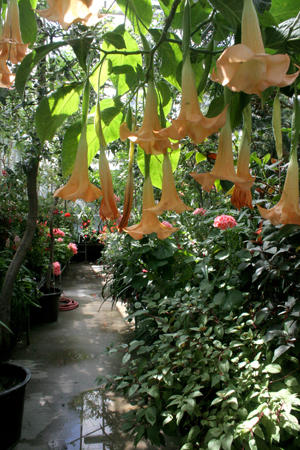
In the distance, you see the famous titan arum towering above everything around it. The humidity sticks to your face and the smell of plant life goes up your nostrils as you make your way through the brush to the arum. Looking up at this rare and unique plant, you find it amazing to finally see one in real life instead of in the textbooks. Taking in your surroundings, you come to realize that you are in the E.W. Heir Teaching Greenhouse in Binghamton University.
A grower in Hawaii donated the titan arum to BU in September when it was just a 5 pound corn. Now, taller than the average man and weighing 10 pounds, the plant and is on the verge of breaking its pot.
The plant is native to Sumatra, Indonesia and the flower is usually eaten. The arum first puts out big leaves for a couple of years in increasingly larger steps, and then finally flowers. Lehman College in the Bronx had a titan arum which weighed 30 pounds when it flowered.
According to Laurie Kasperek, greenhouse manager since January and greenhouse assistant since 2007, the greenhouse had a small titan arum which released its stench throughout the greenhouse, hallways and even staircases. The smell can “only be described by some as rotting roadkill,” Kasperek said. The smell attracts carrion beetles which pollinate the flower. The flower also gives off heat.
Many universities with titan arums put their flowers up for display over a Web cam.
“If and when it develops, there is a good possibility we will set up a Web cam” Kasperek said.
BU’s first greenhouse was completed in 1961 as a part of Science 1. The current structure, which is connected to Science 3, was completed In 1981. The facility is 12,500 feet and houses four environments — warm temperate, cool temperate, desert and tropic.
The greenhouse “provides support for courses — biology, botany, geography courses, art classes, even English classes come. Outside groups come to visit as well. A lot of students from the local schools make trips. Local garden clubs visit,” Kasperek said. Most of the plants in the greenhouse were started by seed, and the variety of plants depends on what researchers and professors need for their courses.
The greenhouse’s success has not gone without any hindrances. Over the winter, white flies swarmed the hibiscus. The flies were not affected by pesticides and are still there. But, after testing was done, they turned out to be sweet potato flies and not a resistant strain. The greenhouse is participating in BU’s “green” efforts by using beneficial insects like the parasitic wasp instead of spraying to eliminate the flies.
The warm temperate section houses plants from central Florida, Central America and other warm temperate areas. This section includes orchids, cyads, grapefruits, coffee beans, papyrus and water lilies.
“Cyads look like palms, but these are one of the most ancient plants, found in the fossil records,” Kasperek said.
The greenhouse’s oldest cyad is 80 to 85 years old. The grapefruits are species that are bitter and not like what you will find in the stores.
The cool temperate area of the greenhouse is 40 to 42 degrees Fahrenheit in the winter, when plants go fully dormant. The Valencia orange and angels trumpet can be found here.
Right next door to the cool temperate area is the desert section, which houses new world (North America) and old world (Europe, Asia, Africa) cacti. Many of these cacti flower. They are watered once or twice a week in the summer and once or twice a month in the winter.
The tropical area of the greenhouse houses the titan arum, banana tree, coconut palms and cocoa tree. Misters humidify the room in the morning.
The greenhouse is “such an exotic aspect of our campus. Even if you just take a walk through once, I guarantee you there will be something that will spark your interest,” said Maria Racioppo, a senior biology major who works in the greenhouse.
The greenhouse is open from 8:30 a.m. to 4:30 p.m. on weekdays, but call before you come to verify that it is not closed for spraying. Students and the public are welcome to visit.
Self-guided tours with descriptions and pictures are available online at biogreenhouse.binghamton.edu/tourscript.htm.


